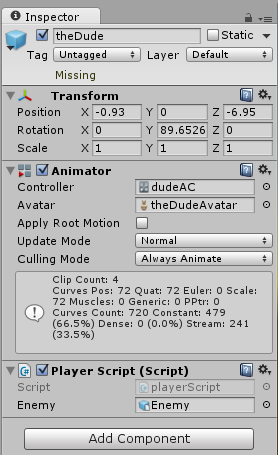Finalizing the fight
Let us make the player react to the enemy's attacks by changing the behavior of the player. In the playerScript, add the following line of code. At the top of the class, create a new public variable of type GameObject and call it enemy:
public GameObject enemy;
Next, at the start of the Update function, get the Animator component of the enemy:
Animator eAnim = enemy.GetComponent<Animator>();
Next, after the attacking function in the update, add the following:
// Getting Hit
if (eAnim.GetBool("tIsPunching")){
if (anim.GetBool("bIsDefending") == false){
//Debug.Log("I got hit");
anim.SetTrigger("tGotHit");
}
} Here, we check if the enemy is punching. If the enemy is punching and the player is not defending, then we set the gotHit trigger to be true.
Drag theDude character to the enemy script component as shown in the following screenshot:

Similarly, in the enemy script add a public GameObject variable...



































































